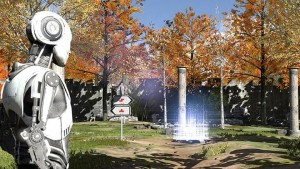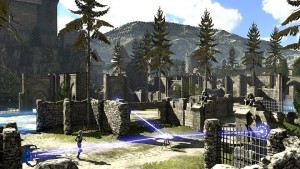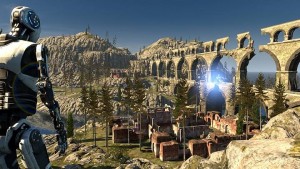Liverpool Sound and Vision Rating 9.5 out of 10
The Talos Principle is a first-person and third-person adventure puzzle game available from retail stores and for download from the PlayStation Store for the PS4. The Talos Principle has a great pedigree as the development team at Croteam have created and continued to positively build upon the Serious Sam series which began in 2001 with Serious Sam: The First Encounter. The Talos Principle is Croteam’s debut on PS4 and is their first game utilising their own brand new Serious Sam 4 graphics engine.
The story is a collaboration between Tom Jubert who is particularly known for his excellent story writing for such games as FTL: Faster Than Light and The Swapper and Jonas Kyratzes who has written such games as The Infinite Ocean, The Strange and Somewhat Sinister Tale of the House at Desert Bridge and Moonlight. The story is exceptional in its dialogue and philosophical message with three unique endings depending upon the actions of players.
The story is quite philosophical with the word Talos taken from Greek mythology as a disembodied voice called Elohim instructs a robot who has just gained consciousness to explore the lands, overcoming obstacles and puzzles who serve Elohim as they are placed in his way as an additional test to challenge the robot during his search for a series of hidden shapes referred to as sigils which the robot can pass down generation by generation and which holds the key to eternal life.
There are over 120 complex puzzles with a sigil hidden amongst each of them with at least 2 of them needing to be retrieved and entered into a locked iron gate by slotting the pieces together in a style reminiscent of Tetris to be able to open the iron gate and move beyond it onto the next set of puzzles. An earlier gameplay element is centred around jammers which need to be positioned precisely and aimed at force field gates which are effectively electromagnetic barriers and enemies as a means to disable them in order for the robot to progress beyond them. It is also important to realise that sigils are not the only item of interest to collect as there are 30 gold stars hidden throughout the environments of the main game with a further 11 gold stars hidden amongst the environments of the Road to Gehenna expansion.
Additional elements to puzzles are gradually introduced such as a jammer being locked behind an iron gate which must be opened by a key that must be found as the jammer is important to working towards finding the sigil, or in another case utilising a jammer to move past a force field gate in order to find the keys beyond it which open an iron gate which results in the jammer no longer needing to focus on the force field gate, therefore allowing that to be focused at the nearby turret allowing the robot to reach the next jammer at the end of the path. There are also strategically challenging elements even in the very same instance of the same puzzle in which after collecting the second jammer it must be placed looking back at the force field, therefore allowing the previous jammer to be positioned beyond the force field as one of the jammers must be focused at the second turret in order for it to be disabled as the first jammer is then moved to remove the other force field guarding the sigil before obtaining the sigil and escaping over the ladder.
Further gameplay elements involving a range of tools are introduced after some decent progression including a major feature being a recorder which accounts for the robot’s movements for a limited period of time or until the player decides to end the recording in which playback of those movements can be engaged to interact with the surrounding environments, for instance deactivating a force field gate in order to have a window of opportunity to manoeuvre beyond the obstacle and continue towards successfully overcoming the puzzle. Another introduction of a gameplay mechanic which is unavailable at the very start of the game is fans that propel the robot high up into the air over large walls, although some fans have to be assembled with a base sometimes being located away from the fan and fans have to be powered on at that given moment by applying weight to a pressure plate or utilising a receiver or a wall switch to guarantee power is flowing into the fan before stepping on it.
Computer terminals can be found in certain areas which hold a system that includes a library archive of resources and the ability to respond to certain queries which the robot asks to gain knowledge of not only his surroundings, but also his purpose and how he came to be, although there is also a range of hexadecimal codes contained within the computer terminals which can be translated to view additional messages, while there are QR codes on the walls which when scanned display messages left by previous inhabitants regarding a variety of matters and 22 time capsules which play audio diaries recorded by a woman called Alexandra Drennan that collectively provide a greater unfolding back story.
Messenger islands become available after finding an axe to chop through wooden barriers to find extra portals in which the messenger islands will contain their own puzzles. These must be solved using some of the sigils which have been collected from earlier puzzles to unlock the path to find messengers who have been locked away within the islands, which is important as messengers can help and be of guidance in certain areas.
The Road to Gehenna expansion is immediately included in the PS4 version which sees players returning to a hidden area of the simulation as Elohim’s messenger, called Uriel, is sent in an attempt to free souls imprisoned in a mysterious place with the expansion providing over 20 of the more advanced puzzles to challenge even the very best puzzle solving players of The Talos Principle.
The character design is exceptional as the player makes a genuine connection with the robot as it is attempting to learn as a child would and the look of the robot seems to reflect this innocence, while the enemy design mostly consists of pivoting machine gun turrets which focus their sights from side to side and patrolling enemies.
The environment design is excellent as it is rather varied and unique as it is set in a simulation of the world’s greatest and most historic ruins, dilapidated buildings, structures and a variety of statues, while there is a lot of foliage scattered throughout the environments and large volumes of water surrounding the islands containing the ancient ruins with picturesque skies up above.
Players have a surprising amount of freedom regarding the positioning of the camera with three camera angles including a first-person perspective from the eyes of the robot and two third-person perspectives including an over the left shoulder view and an over the right shoulder view which is an excellent design choice as it opens the game up beyond gamers who gravitate towards first-person or third-person games by providing the best of both worlds.
If The Talos Principle was available natively on Vita it would undoubtedly be the ultimate portable puzzle game, but as a consolation there is remote play functionality. The performance during remote play is on par with the graphics, audio and general performance of the PS4 version, while the most comfortable control scheme during remote play has to be Standard V which retains pressing X to jump and removes L as the optional alternative for jumping with sprinting moving from the top left of the touch screen in Standard A to L in Standard V, therefore as the controls remain pretty much identical as the PS4 version thus resulting in a satisfying remote play experience.
The controls are well mapped to the DualShock 4 controller with four standard control schemes and four control schemes for left-handed players to choose from as well as four analogue stick layouts in addition which results in players definitely finding a set of controls that is perfect for each and every player. The default Standard A control scheme consisting of pressing X or L1 to jump, pressing square or R1 to use an item, holding L2 to sprint, pressing O to open the journal, pressing triangle to reset, pressing the share button takes players to the share feature menu and pressing the options button to display the pause menu. The standard stick layout consists of changing the direction of the left analogue stick to the left or right to strafe and up or down to move forwards or backwards, changing the direction of the right analogue stick to the left or right to look around and up or down to look upwards or downwards.
The touch pad is utilised to interact with the sigils collected during puzzles when interacting with padlocks which can only be unlocked by arranging the sigils correctly in a fashion that is reminiscent of Tetris as swiping across the touch pad manoeuvres the cursor. Tapping the touch pad selects a sigil followed by swiping across the touch pad to appropriately position it within the padlock, gently touching the surface of the touch pad will rotate the shape of the sigil and tapping the touch pad to insert it into the padlock, while the DualShock 4 controller vibrates when the robot locks onto an enemy or force field gate with the jammer, when passing through a checkpoint gate and when falling back to the ground after jumping in the air. There is no light bar implementation which could have produced green when not in danger, flashed red when a patrolling enemy, machine gun turret or other enemies had suspicions of your robot being nearby and remaining a sustained red when being attacked by an enemy.
Croteam’s Serious Sam 4 engine produces stunning detail throughout the ancient ruins including mosaic tapestries on the floors and steps of pools which are complimented with amazing visual effects such as portal effects, the electrical effect produced by the jammer, lighting, shadows, water rippling and reflection of sunlight, swaying foliage and realistic skies.
The presentation of the game is solid with a great user interface across various menus such as the main, chapter, options and gameplay menus with support for navigation via the left and right analogue sticks, directional pad and face buttons, although it does not include support for navigation via the touch pad. The background of the main menu focuses upon the ancient ruins the game is set within as a camera pans around them as they are showcased in magnificent detail and accompanied by beautiful Gregorian chants.
The voice-over artists bring a story and progressive meaning to the game which forms as a character within itself due to exceptional performances from Timothy Wilson as the disembodied voice of Elohim who has previously starred in a variety of games such as Soma, Everybody’s Gone to the Rapture, Final Fantasy XIV: Heavensward, The Witcher 3: Wild Hunt and Puppeteer, while Erin Fitzgerald voices Alexandra Drennan who is the woman heard in the time capsules scattered throughout the environments having previously voiced a variety of roles in games such as the English versions of Persona 4: Dancing All Night, Persona 4: Arena Ultimax, Persona Q: Shadow of the Labyrinth and Conception 2: Children of the Seven Stars.
Sound effects include walking, running, interacting with computer terminals, patrolling enemies scanning their surrounding environments, electricity from the jammer and static produced by the force fields. The music includes a lengthy, varied and thought provoking soundtrack composed by Damjam Mravunac who has previously composed for Croteam’s Serious Sam series which comprises melodic harmonies and piano, while also including atmospheric yet relaxing and wondrous tones that tie perfectly with the subject matter at hand. There is no DualShock 4 speaker implementation, although it could have produced voice-overs from the disembodied voice of Elohim and the time capsule recordings of Alexandra Drennan or a variety of sound effects or perhaps even the soundtrack.
The trophy list includes 40 trophies with 20 bronze, 16 silver, 3 gold and 1 platinum trophy. Easier trophies include the Logic Check…OK bronze trophy for completing the tutorial; the Halls of His Temple bronze trophy for stepping into the portal after completing some of the initial puzzles; The Last Stable Version bronze trophy for quitting out to the main menu and selecting the Restore Backup option. Harder trophies include the Thorough Researcher silver trophy for collecting all written information from all computer terminals; the A Good Listener silver trophy for collecting all time capsules and the Blessed Messenger gold trophy for solving every mystery in every land comprising of completing all puzzles, collecting all sigils, collecting all stars and completing all messenger islands. It is estimated that depending upon skill and a good trophy guide to provide some helpful tips that it would take between 30 to 40 hours to platinum the trophy list.
There are no difficulty levels resulting in the difficulty curve being as hard as players find the over 120 puzzles to be, although even Croteam could not fundamentally test every version of every puzzle during the development process after any adjustments made by level designers in which they designed an in-game A.I. robot called Bot to test every puzzle design throughout the entire game to guarantee that each puzzle could be solved by fair logical thinking from human players with an estimated total of 80,000 hours of testing, therefore there are most certainly a huge amount of challenging puzzles, however rest assured that taking a step back and carefully analysing each layer of the puzzle will provide the best logical approach to see players through to the end of every puzzle.
There is no local or online co-operative or competitive multiplayer which is surprising as the local competitive multiplayer could have included a pass the controller feature in which both players attempted to complete an individual puzzle or a series of puzzles in a faster time than the other players participating or a split-screen variant for players with multiple controllers, while the online competitive multiplayer could have mirrored the local competitive multiplayer by allowing two to eight players or so into a lobby as each player simultaneously attempts to complete a single puzzle or consecutive puzzles in the fastest times possible, alongside a possible co-operative multiplayer component which could have been explored naturally by utilising the recorder and playback gameplay mechanics.
There is no online leaderboards which is surprising as it could have featured every player’s best times for completing each puzzle and the fastest times for completing every puzzle as well as how many puzzles have been completed and how many attempts each player required before successfully completing each individual puzzle and each player’s collective amount of attempts from the combination of all puzzles.
The replayability stems from a vast array of areas including over 120 puzzles plus the immediate inclusion of the Road to Gehenna expansion including over 20 puzzles which is complimented by having at least 3 endings, a huge amount of collectables such as 30 gold stars secretly positioned throughout a variety of puzzles, 22 time capsules, QR codes to be found and scanned around the environments, Hexadecimal codes to be translated at the computer terminals, a large quantity of areas, tools and gameplay mechanics to unlock access to throughout the game and even the freedom of having 3 camera angles to choose from to suit players who prefer first-person or third-person perspectives which collectively provides an exceptional range of replay value for players to enjoy for dozens of hours.
Overall, The Talos Principle successfully finely balances gameplay which allows for a rewarding experience, despite providing a genuine challenge to even the most veteran players of the puzzle genre, therefore if you are a fan of puzzle games, then The Talos Principle is an absolute gem to add to your must purchase list and if this is any indication of the quality players can expect from Serious Sam 4, then there are serious reasons for players to wait with anticipation for Croteam’s next masterpiece.
Jason Bonnar
Analysis
- Title: The Talos Principle: Deluxe Edition
- Developer: Croteam
- Publisher: Devolver Digital
- System: PS4
- Format: Blu-Ray Disc/PSN Download
- Cross-Buy: No
- Cross-Play: No
- Players: 1
- Hard Drive Space Required:8GB (Version 1.01)


